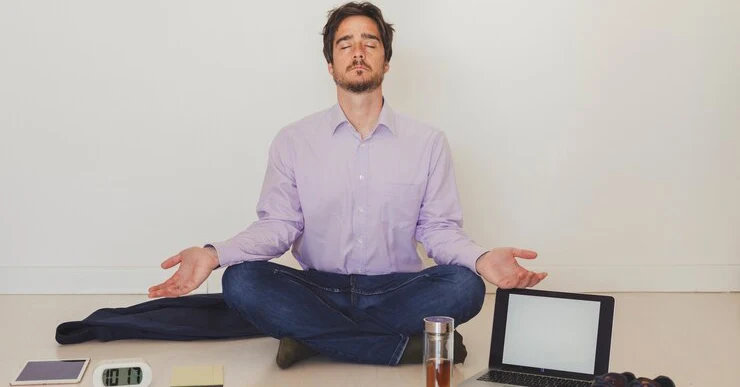Introduction
Respiration is a routine activity, often executed without conscious consideration or exertion. But did you know that the way you breathe can have a profound impact on your overall well-being? Breath work is the practice of consciously using the breath or breathing techniques for a specific purpose and outcome. It can help you improve your physical, mental, and spiritual health, as well as your self-awareness, creativity, and confidence.
Breath work has been used for thousands of years in various traditions, such as yoga, meditation, and shamanism. It has many benefits, such as:
- Alkalizing your blood pH and reducing inflammation
- Elevating your mood and releasing negative emotions
- Enhancing your immune system and detoxifying your body
- Calming your nervous system and lowering your stress levels
- Increasing your energy and vitality
- Expanding your consciousness and accessing altered states
Breath work can also positively impact your physical and mental health by regulating your heart rate, blood pressure, oxygen levels, and brain activity. It can help you cope with various issues, such as anxiety, depression, trauma, chronic pain, grief, and addiction.
There are many types of breath work, each with its own goals, techniques, and effects. In this article, we will focus on one of the most common and basic forms of breath work: diaphragmatic breathing.
Diaphragmatic Breathing
Diaphragmatic breathing, also known as belly breathing or abdominal breathing, is a technique that involves breathing deeply and fully from your diaphragm, the large muscle that separates your chest and abdomen. When you breathe from your diaphragm, you allow more air to enter and exit your lungs, which improves your oxygen intake and carbon dioxide elimination.
To practice diaphragmatic breathing, follow these steps:
- Assume a relaxed posture, whether reclining, seated, or upright.
- Rest one hand on your chest and the other on your abdomen, just beneath your rib cage.
- Breathe in slowly through your nose, feeling your belly rise as it fills with air. Your chest should remain still or move slightly.
- Breathe out slowly through your mouth, feeling your belly fall as it empties. You can purse your lips as if you are blowing a candle.
- Repeat this cycle for several minutes, keeping your breath smooth and steady.
Diaphragmatic breathing has many benefits for relaxation and stress reduction. It can help you:
- Relax your muscles and release tension
- Lower your heart rate and blood pressure
- Activate your parasympathetic nervous system, which is responsible for rest and digestion
- Reduce the production of stress hormones, such as cortisol and adrenaline
- Boost the secretion of endorphins, the body’s innate pain-relievers and mood enhancers.
- Improve your mental clarity and focus
Diaphragmatic breathing is a simple and effective way to enhance your well-being. By practicing it regularly, you can improve your physical and mental health, as well as your emotional and spiritual well-being. You can also use it as a foundation for other types of breath work, such as 4-7-8 breathing, alternate nostril breathing, and breath of fire. Breath work is a powerful tool that can help you transform your life. All you need is your breath and your intention.
Box Breathing (Square Breathing)
Box breathing, also known as square breathing, is a technique that involves breathing in a rhythmic and symmetrical pattern. It is called box breathing because each phase of the breath is equal in length, forming a square or a box.
To practice box breathing, follow these four steps:
- Inhale for four seconds, filling your lungs with air.
- Hold your breath for four seconds, keeping your chest still.
- Exhale for four seconds, emptying your lungs completely.
- Hold your breath for four seconds, relaxing your body.
Repeat this cycle for several minutes, keeping your breath smooth and steady.
Box breathing can help you manage anxiety and improve focus by:
- Regulating your nervous system and activating your parasympathetic response, which is responsible for rest and relaxation
- Reducing the effects of stress hormones, such as cortisol and adrenaline, which can cause anxiety and panic
- Increasing your oxygen intake and carbon dioxide elimination can improve your brain function and mental clarity
- Enhancing your concentration and attention span, by creating a focal point for your mind
- Calming your emotions and thoughts, by creating a sense of rhythm and harmony
Box breathing is a simple and effective way to cope with anxiety and improve focus. You can practice it anytime and anywhere, especially before or during stressful situations, such as exams, presentations, or interviews.
Mindful Breathing
Mindful breathing is a technique that involves paying attention to your breath, without trying to change or control it. It is a form of mindfulness, which is the practice of being aware of the present moment, without judgment or distraction.
Mindfulness can be applied to the breath by:
- Observing the sensations of your breath, such as the temperature, the speed, the depth, and the sound
- Noticing the movements of your body, such as the rise and fall of your chest and abdomen, the expansion and contraction of your ribs, and the tension and relaxation of your muscles
- Acknowledging the thoughts and feelings that arise in your mind, such as worries, memories, or fantasies, without getting attached or involved with them
- Returning your attention to your breath, whenever you notice that your mind has wandered away
Mindful breathing can help you incorporate mindfulness into your breathing practices by:
- Developing your awareness and self-observation skills can help you understand yourself better and improve your emotional regulation
- Cultivating your acceptance and compassion skills, which can help you cope with difficult emotions and situations, without judging or resisting them
- Enhancing your relaxation and stress reduction skills, which can help you calm your nervous system and lower your blood pressure
- Improving your mental health and well-being, by reducing the symptoms of anxiety, depression, and stress-related disorders
Mindful breathing is a powerful way to practice mindfulness and enhance your well-being. You can practice it anytime and anywhere, especially when you feel overwhelmed, distracted, or restless.
Alternate Nostril Breathing (Nadi Shodhana)
Alternate nostril breathing, also known as Nadi Shodhana, is a technique that involves breathing through one nostril at a time while closing the other nostril with your fingers. It is a form of pranayama, which is the yogic practice of controlling the breath or life force.
To engage in alternate nostril breathing, adhere to these instructions:
- Find a relaxed position, ensuring your back is upright and your shoulders are eased.
- Position your right thumb on your right nostril and your right ring finger on your left nostril.
- Close your right nostril with your thumb and inhale through your left nostril, filling your lungs with air.
- Close your left nostril with your finger and exhale through your right nostril, emptying your lungs completely.
- Breathe in through your right nostril, filling your lungs with air.
- Close your right nostril with your thumb and exhale through your left nostril, emptying your lungs completely.
- This completes one cycle. Repeat this cycle for several minutes, keeping your breath smooth and steady.
Alternate nostril breathing can help you balance and calm your body and mind by:
- Balancing the left and right hemispheres of your brain, which are responsible for different functions, such as logic and creativity, analysis and intuition, and action and rest
- Balancing the nadis, which are the subtle energy channels that run through your body, according to the yogic philosophy
- Calming your nervous system and activating your parasympathetic response, which is responsible for rest and relaxation
- Reducing the effects of stress hormones, such as cortisol and adrenaline, which can cause anxiety and agitation
- Increasing your oxygen intake and carbon dioxide elimination can improve your brain function and mental clarity
- Enhancing your concentration and attention span, by creating a focal point for your mind
- Calming your emotions and thoughts, by creating a sense of harmony and peace
Alternate nostril breathing is a simple and effective way to balance and calm your body and mind. You can practice it anytime and anywhere, especially when you feel unbalanced, agitated, or confused.
4-7-8 Breathing Technique
The 4-7-8 breathing technique, also known as the relaxing breath, is a technique that involves breathing in a specific pattern that can help you calm your mind and body. It is based on the ancient yogic practice of pranayama, which means control of the breath or life force.
To engage in the 4-7-8 breathing method, adhere to these guidelines:
- Please find a comfortable seated position, ensuring your spine is erect and your shoulders are at ease.
- Place the tip of your tongue behind your upper front teeth, and keep it there throughout the practice.
- Exhale completely through your mouth, making a whooshing sound.
- Stop your mouth and inhale quietly through your nose for four counts.
- Hold your breath for seven counts.
- Exhale loudly through your mouth, making a whooshing sound, for eight counts.
- This completes one cycle. Repeat this cycle four more times, for a total of five cycles.
The 4-7-8 breathing technique has many benefits for relaxation and improved sleep:
- Slowing down your breathing rate and extending your exhalation, which can lower your heart rate and blood pressure, and activate your parasympathetic nervous system, which is responsible for rest and relaxation
- Increasing your oxygen intake and carbon dioxide elimination can improve your brain function and mental clarity
- Reducing the effects of stress hormones, such as cortisol and adrenaline, which can cause anxiety and insomnia
- Relaxing your muscles and releasing tension
- Inducing a state of calmness and tranquility
The 4-7-8 breathing technique is a simple and effective way to relax and improve your sleep. You can practice it anytime and anywhere, especially before bedtime or when you feel stressed or anxious.
Breath Awareness Meditation
Breath awareness meditation is a technique that involves focusing your attention on your natural breathing, without trying to change or control it. It is a form of mindfulness meditation, which is the practice of being aware of the present moment, without judgment or distraction.
To practice breath awareness meditation, follow these steps:
- Discover a relaxed posture, whether reclining, seated, or upright.
- Stop your eyes or lower your gaze, and relax your body and mind.
- Direct your focus to your breath, observing its rhythm as it moves in and out of your body.
- Observe the sensations of your breath, such as the temperature, the speed, the depth, and the sound.
- If your mind wanders away from your breath, gently bring it back, without criticizing or blaming yourself.
- Continue to focus on your breath, for as long as you wish.
Breath awareness meditation has many benefits for mindfulness and stress relief:
- Developing your awareness and self-observation skills can help you understand yourself better and improve your emotional regulation
- Cultivating your acceptance and compassion skills, which can help you cope with difficult emotions and situations, without judging or resisting them
- Enhancing your relaxation and stress reduction skills, which can help you calm your nervous system and lower your blood pressure
- Improving your mental health and well-being, by reducing the symptoms of anxiety, depression, and stress-related disorders
Breath awareness meditation is a powerful way to practice mindfulness and enhance your well-being. You can practice it anytime and anywhere, especially when you feel overwhelmed, distracted, or restless.
Incorporating Breath Work into Daily Life
Breath work is a valuable practice that can help you improve your physical, mental, and spiritual health, as well as your self-awareness, creativity, and confidence. However, to reap the full benefits of breath work, you need to incorporate it into your daily life, and make it a habit.
Here are some tips on how to seamlessly integrate breath work into your daily routines:
- Start your day with a few minutes of breath work, to energize your body and mind, and set a positive intention for the day.
- Use breath work as a break, whenever you feel tired, bored, or stressed, to refresh your mood and focus.
- Use breath work as a tool, whenever you face a challenge, a problem, or a decision, to calm your emotions and thoughts, and access your intuition and creativity.
- End your day with a few minutes of breath work, to relax your body and mind, and prepare for a good night’s sleep.
Here are some suggestions for using breath work during moments of stress or tension:
- Use diaphragmatic breathing, to relax your muscles and release tension.
- Use box breathing, to regulate your nervous system and lower your stress levels.
- Use 4-7-8 breathing, to induce a state of calmness and tranquility.
- Use mindful breathing, to cultivate acceptance and compassion for yourself and others.
- Use alternate nostril breathing, to balance your left and right brain, and create a sense of harmony and peace.
The most important thing to remember is to be consistent in developing a breath work practice. The more you practice, the more you will benefit from it. You can begin with a brief period daily, and progressively escalate both the length and regularity of your routine. You can also experiment with different types of breath work, and find the ones that suit you best.
Conclusion
Breath work is a simple and effective way to enhance your well-being. By practicing it regularly, you can improve your physical and mental health, as well as your emotional and spiritual well-being. You can also use it as a foundation for other types of breath work, such as 4-7-8 breathing, alternate nostril breathing, and breath of fire. Breath work is a powerful tool that can help you transform your life. All you need is your breath and your intention.
In this article, we have introduced seven breath work techniques for beginners, namely:
- Diaphragmatic breathing, which involves breathing deeply and fully from your diaphragm, the large muscle that separates your chest and abdomen.
- Box breathing, which involves breathing in a rhythmic and symmetrical pattern, forming a square or a box.
- Mindful breathing, which involves paying attention to your breath, without trying to change or control it.
- Alternate nostril breathing, which involves breathing through one nostril at a time, while closing the other nostril with your fingers.
- 4-7-8 breathing technique, which involves breathing in a specific pattern that can help you calm your mind and body.
- Breath awareness meditation, which involves focusing your attention on your natural breathing, without trying to change or control it.
- Incorporating breath work into daily life, which involves seamlessly integrating breath work into your daily routines, and using it during moments of stress or tension.
We encourage you to explore and experiment with these techniques and find the ones that work best for you. You can also learn more about other types of breath work, such as breath of fire, holotropic breathing, and the Wim Hof method, and discover their benefits and effects.
Breath work is a simple and effective way to enhance your well-being. It can help you improve your physical, mental, and spiritual health, as well as your self-awareness, creativity, and confidence. It can also help you cope with various issues, such as anxiety, depression, trauma, chronic pain, grief, and addiction. Breath work is a powerful tool that can help you transform your life. All you need is your breath and your intention.
FAQ
How do I start practicing breathwork?
Breathwork is the practice of consciously using the breath or breathing techniques for a specific purpose and outcome. It can help you improve your physical, mental, and spiritual well-being, as well as your self-awareness, creativity, and confidence.
To start practicing breathwork, you need to find a comfortable and quiet place where you can pay attention to your breathing. You can sit, lie down, or stand, as long as you have good posture and can breathe freely. You can also use music, candles, aromatherapy, or other tools to create a relaxing atmosphere.
There are many types of breathwork, each with its own goals, techniques, and effects. You may want to try out a few different techniques over time to see which one most resonates with you and brings about the best results. Some examples of breathwork techniques are:
- Diaphragmatic breathing, which involves breathing deeply and fully from your diaphragm, the large muscle that separates your chest and abdomen.
- Box breathing, which involves breathing in a rhythmic and symmetrical pattern, forming a square or a box.
- Mindful breathing, which involves paying attention to your breath, without trying to change or control it.
- Alternate nostril breathing, which involves breathing through one nostril at a time, while closing the other nostril with your fingers.
- 4-7-8 breathing technique, which involves breathing in a specific pattern that can help you calm your mind and body.
- Breath awareness meditation, which involves focusing your attention on your natural breathing, without trying to change or control it.
You can find more information and instructions on how to do these techniques in the web search results below.
The most important thing to remember is to be consistent in developing a breathwork practice. The more you practice, the more you will benefit from it. You can start with a few minutes a day, and gradually increase the duration and frequency of your practice. You can also experiment with different types of breathwork, and find the ones that suit you best.
What is the 4 6 7 breathing method?
The 4 6 7 breathing method is a variation of the 4-7-8 breathing technique, which involves breathing in for 4 seconds, holding the breath for 7 seconds, and exhaling for 8 seconds. The 4 6 7 breathing method follows a similar pattern, but with different counts:
- Inhale for 4 seconds, expanding your chest with breath.
- Hold your breath for 6 seconds, keeping your chest still.
- Exhale for 7 seconds, emptying your lungs completely.
This breathing method is designed to help you relax and reduce stress by slowing down your breathing rate and extending your exhalation. It can also help you activate your parasympathetic nervous system, which is responsible for rest and relaxation, and reduce the effects of stress hormones, such as cortisol and adrenaline.
You can practice the 4 6 7 breathing method anytime and anywhere, especially before or during stressful situations, such as exams, presentations, or interviews. You can also use it to help you fall asleep, as it can induce a state of calmness and tranquility.
What is the 5 breath technique?
The 5 breath technique is a simple breathing exercise that involves taking five deep and slow breaths. It can help you calm down and relax in moments of stress or anxiety. To do the 5 breath technique, follow these steps:
- Discover a relaxed posture, whether reclining, seated, or upright.
- Block your vision or diminish your gaze, and soothe your body and mind.
- Center your attention on your breath, and become aware of its steady movement in and out of your being.”
- “Turn your
- Take a deep breath through your nose, and count to five in your head.
- Exhale slowly through your mouth, and count to five in your head.
- Repeat this four more times, for a total of five breaths.
The 5 breath technique can help you by:
- Regulating your nervous system and activating your parasympathetic response, which is responsible for rest and relaxation.
- Reducing the effects of stress hormones, such as cortisol and adrenaline, which can cause anxiety and panic.
- Increasing your oxygen intake and carbon dioxide elimination, which can improve your brain function and mental clarity.
- Relaxing your muscles and releasing tension.
- Inducing a state of calmness and tranquility.
You can practice the 5 breath technique anytime and anywhere, especially when you feel overwhelmed, nervous, or angry. It can also help you cope with physical pain, such as headaches, cramps, or soreness.
How do beginners breathe?
Breathing is something we do every day, without much thought or effort. But breathing properly can have a profound impact on our overall well-being. Breathing properly means using your diaphragm, the large muscle that separates your chest and abdomen, to breathe deeply and fully. This allows more air to enter and exit your lungs, which improves your oxygen intake and carbon dioxide elimination.
To breathe properly as a beginner, you can follow these tips:
- Place one hand on your chest and one hand on your belly, just below your rib cage. This will help you feel the movement of your diaphragm.
- Breathe in slowly through your nose, feeling your belly rise as it fills with air. Your chest should remain still or move slightly.
- Breathe out slowly through your mouth, feeling your belly fall as it empties. You can purse your lips as if you are blowing a candle.
- Repeat this cycle for several minutes, keeping your breath smooth and steady.
Breathing properly can help you by:
- Alkalizing your blood pH and reducing inflammation.
- Elevating your mood and releasing negative emotions.
- Enhancing your immune system and detoxifying your body.
- Calming your nervous system and lowering your stress levels.
- Increasing your energy and vitality.
- Expanding your consciousness and accessing altered states.
Breathing properly is a simple and effective way to enhance your well-being. By practicing it regularly, you can improve your physical, mental, and spiritual health, as well as your self-awareness, creativity, and confidence. You can also use it as a foundation for other types of breathwork, such as 4-7-8 breathing, alternate nostril breathing, and breath of fire.
What is breath work and why is it beneficial?
Breath work is the practice of consciously using the breath or breathing techniques for a specific purpose and outcome. It can help you improve your physical, mental, and spiritual well-being, as well as your self-awareness, creativity, and confidence. Breath work can also help you cope with various issues, such as anxiety, depression, trauma, chronic pain, grief, and addiction.
What are the six ways to practice breath work for beginners?
The six ways to practice breath work for beginners are:
- Diaphragmatic breathing, which involves breathing deeply and fully from your diaphragm, the large muscle that separates your chest and abdomen.
- Box breathing, which involves breathing in a rhythmic and symmetrical pattern, forming a square or a box.
- Mindful breathing, which involves paying attention to your breath, without trying to change or control it.
- Alternate nostril breathing, which involves breathing through one nostril at a time, while closing the other nostril with your fingers.
- 4-7-8 breathing technique, which involves breathing in a specific pattern that can help you calm your mind and body.
- Breath awareness meditation, which involves focusing your attention on your natural breathing, without trying to change or control it.
How do I practice diaphragmatic breathing?
To practice diaphragmatic breathing, follow these steps:
- Discover a cozy posture, whether reclining, seated, or upright.
- Position one hand on your chest and the other on your abdomen, just beneath your rib cage.
- Breathe in slowly through your nose, feeling your belly rise as it fills with air. Your chest should remain still or move slightly.
- Breathe out slowly through your mouth, feeling your belly fall as it empties. You can purse your lips as if you are blowing a candle.
- Repeat this cycle for several minutes, keeping your breath smooth and steady.
How do I practice box breathing?
To practice box breathing, follow these four steps:
- Inhale for four seconds, filling your lungs with air.
- Pause your breathing for four seconds, while maintaining a steady chest.
- Exhale for four seconds, emptying your lungs completely.
- Hold your breath for four seconds, relaxing your body.
- Repeat this cycle for several minutes, keeping your breath smooth and steady.
How do I practice mindful breathing?
To practice mindful breathing, follow these steps:
- Discover a comfortable position, either lying down, sitting, or standing.
- Block your eyes or lower your gaze, and relax your body and mind.
- Direct your focus to your breath, and observe its rhythm as it enters and exits your body.
- Observe the sensations of your breath, such as the temperature, the speed, the depth, and the sound.
- If your mind wanders away from your breath, gently bring it back, without criticizing or blaming yourself.
- Continue to focus on your breath, for as long as you wish.
How do I practice alternate nostril breathing?
To engage in alternate nostril breathing, adhere to these instructions:
- Find a relaxed position, ensuring your back is upright and your shoulders are eased.
- Apply pressure to your right nostril with your right thumb and to your left nostril with your right ring finger.
- Close your right nostril with your thumb and inhale through your left nostril, filling your lungs with air.
- Close your left nostril with your finger and exhale through your right nostril, emptying your lungs completely.
- Breathe in through your right nostril, filling your lungs with air.
- Close your right nostril with your thumb and exhale through your left nostril, emptying your lungs completely.
- This completes one cycle. Repeat this cycle for several minutes, keeping your breath smooth and steady.
How do I practice the 4-7-8 breathing technique?
To engage in the 4-7-8 breathing method, adhere to these guidelines:
- Assume a relaxed posture, ensuring your spine is aligned and your shoulders are eased.
- Place the tip of your tongue behind your upper front teeth, and keep it there throughout the practice.
- Exhale completely through your mouth, making a whooshing sound.
- Stop your mouth and inhale quietly through your nose for four counts.
- Hold your breath for seven counts.
- Exhale loudly through your mouth, making a whooshing sound, for eight counts.
- This completes one cycle. Repeat this cycle four more times, for a total of five cycles.
How do I practice breath awareness meditation?
To practice breath awareness meditation, follow these steps:
- Discover a relaxed posture, whether reclining, seated, or upright.
- Stop your eyes or lower your gaze, and relax your body and mind.
- Direct your focus to your breath, and observe its rhythm as it enters and exits your body.
- Observe the sensations of your breath, such as the temperature, the speed, the depth, and the sound.
- If your mind wanders away from your breath, gently bring it back, without criticizing or blaming yourself.
- Continue to focus on your breath, for as long as you wish.
How often should I practice breath work?
There is no definitive answer to how often you should practice breath work, as it depends on your personal goals, preferences, and schedule. However, some general guidelines are:
- Practice breath work at least once a day, preferably in the morning or evening, to establish a routine and reap the benefits.
- Practice breath work for at least 10 minutes per session, or longer if you feel comfortable and have the time.
- Practice breath work whenever you feel stressed, anxious, tired, or overwhelmed, to calm yourself and regain your balance.
- Practice breath work before or after other activities, such as yoga, meditation, exercise, or work, to enhance your performance and well-being.
What are the possible side effects of breath work?
Breath work is generally safe and beneficial for most people, but it may also cause some side effects, such as:
- Dizziness, lightheadedness, or fainting, due to changes in blood pressure or oxygen levels.
- Nausea, vomiting, or stomach discomfort, due to stimulation of the vagus nerve or diaphragm.
- Tingling, numbness, or muscle spasms, due to hyperventilation or overbreathing.
- Emotional reactions, such as crying, laughing, or anger, due to the release of suppressed feelings or memories.
These side effects are usually mild and temporary, and can be avoided or reduced by:
- Practicing breath work in a safe and comfortable environment, with proper guidance and support.
- Practicing breath work at your own pace and level, without forcing or straining yourself.
- Practicing breath work with awareness and intention, without judging or resisting your experience.
- Practicing breath work with gratitude and compassion, for yourself and others.
How can I learn more about breath work?
There are many ways to learn more about breath work, such as:
- Reading books, articles, blogs, or podcasts about breath work, such as The Breathing Book by Donna Farhi, Breath by James Nestor, or The Art of Breathing by Danny Penman.
- Taking online or offline courses, workshops, or classes on breath work, such as Breathwork Basics by Udemy, [Breathwork for Anxiety] by Skillshare, or [Breathwork for Beginners] by Mindbodygreen.
- Joining online or offline communities, groups, or events on breath work, such as [Breathwork Online], [Breathwork Meetup], or [Breathwork Festival].
- Working with a certified or experienced breath work practitioner, coach, or therapist, who can guide you and tailor the practice to your needs and goals. You can find one through [Breathwork Network], [Breathwork Alliance], or [Breathwork Foundation].
*Image credits- freepik*
Important Notice:
The information provided on “health life ai” is intended for informational purposes only. While we have made efforts to ensure the accuracy and authenticity of the information presented, we cannot guarantee its absolute correctness or completeness. Before applying any of the strategies or tips, please consult a professional medical adviser.















